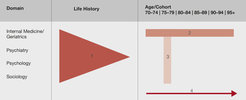Overview
Characteristics

- The comprehensive, intensive examination of a heterogeneous, locally representative sample of 516 old people whose long-term progress is traced across 7 further measurement sessions
- A focus on the very old (70 to over 100)
- A broad-based multidisciplinary approach whose goal is to generate a reference data set spanning a broad range of different functional areas
- The investigation of changes associated with aging and death in the very old
Research Units
Theoretical Orientations
- Differential aging
- Continuity vs. discontinuity
- Plasticity and reserve capacity (range and limits)
- Aging as a systemic phenomenon
Prototypical Questions

- Are individual age differences predictable on the basis of life history data?
- How large are age differences within domains, and which direction do they take?
- How are the transdisciplinary relationships across different domains?
- How do characteristics, processes, links between them change in the course of aging?
Note that the fourth question can only be answered with longitudinal data following individuals as they age.
Selected Publications
Delius, J. A. M., Düzel, S., Gerstorf, D., & Lindenberger, U. (2015). Berlin Aging Studies (BASE and BASE-II). In N. A. Pachana (Ed.), Encyclopedia of geropsychology. Springer. https://doi.org/10.1007/978-981-287-080-3_44-1
Baltes, P. B., Mayer, K. U., Helmchen, H., & Steinhagen-Thiessen, E. (2001). The Berlin Aging Study (BASE): Sample, design, and overview of measures. In P. B. Baltes & K. U. Mayer (Eds.), The Berlin Aging Study: Aging from 70 to 100 (pp. 15–55). Cambridge University Press.
Monographs
The monographs on BASE are available via bookshops.
Lindenberger, U., Smith, J., Mayer, K. U., & Baltes, P. B. (Eds.). (2010). Die Berliner Altersstudie (3rd ext. ed.). Berlin: Akademie Verlag. Table of Contents (in German)
Baltes, P. B., & Mayer, K. U. (Eds.). (1999, 2001). The Berlin Aging Study: Aging from 70 to 100. New York: Cambridge University Press. Table of Contents
Mayer, K. U., & Baltes, P. B. (Eds.). (1996, 1999). Die Berliner Altersstudie (1. & 2. Aufl.). Berlin: Akademie Verlag (out of print).
Introductory Publications
Baltes, P. B., Mayer, K. U., Helmchen, H., & Steinhagen-Thiessen, E. (1993). The Berlin Aging Study (BASE): Overview and design. Ageing and Society, 13, 483–515. doi: 10.1017/S0144686X00001343
Smith, J., & Delius, J. A. M. (2010). Längsschnittliche Datenerhebungen der Berliner Altersstudie (BASE): Studiendesign, Stichproben und Forschungsthemen 1990–2009. In U. Lindenberger, J. Smith, K. U. Mayer, & P. B. Baltes (Eds.), Die Berliner Altersstudie (3rd ed., pp. 113–131). Berlin: Akademie Verlag.
Smith, J., Maas, I., Mayer, K. U., Helmchen, H., Steinhagen-Thiessen, E., & Baltes, P. B. (2002). Two-wave longitudinal findings from the Berlin Aging Study: Introduction to a collection of papers. Journal of Gerontology: Psychological Sciences, 57B, P471–P473. doi: 10.1093/geronb/57.6.P471


